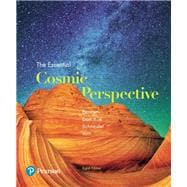About This Book
The Essential Cosmic Perspective, 8th Edition
The Essential Cosmic Perspective, 8th Edition, is a comprehensive textbook designed for one-semester astronomy courses. It's a go-to resource for students and educators alike, offering a detailed exploration of astronomy principles and meeting scope and sequence requirements for typical introductory astronomy courses.
Who Uses It?
Primarily, this book is used by students and instructors in introductory astronomy courses at the college and university levels. It's also a valuable resource for anyone interested in understanding the basics of astronomy, including professionals looking to refresh their knowledge or expand their understanding of celestial bodies and the universe.
History and Editions
The 8th edition of The Essential Cosmic Perspective has been updated to incorporate the latest scientific updates in the field of astronomy. This edition includes new features that reinforce critical thinking and excite students about the wonders of the universe. The text focuses on skill-building, with group work exercises that require active participation. Each chapter is written to specific learning goals, building an ideal learning path for readers.
Author and Other Works
Jeffrey Bennett and Megan Donahue are the authors of The Essential Cosmic Perspective. Jeffrey Bennett is known for his ability to explain complex astronomical concepts clearly and simply, making the subject accessible to readers without a science background. Megan Donahue brings her expertise in astronomy to the text, ensuring that it remains current and relevant.
Key Features
- Comprehensive Coverage: The book covers core concepts in astronomy, including detailed explanations and examples.
- Critical Thinking Emphasis: The text emphasizes critical thinking about our place in the universe, encouraging readers to question and explore the cosmos.
- Interactive Tools: The book is complemented by Mastering Astronomy, which includes interactive features such as Virtual Astronomy Labs, providing assignable online laboratory activities that use Stellarium and Interactive Figures.
- Pedagogical Approach: The authors focus on key concepts, providing big picture context, promoting conceptual understanding, and preferring plain language to jargon.
Detailed Information
ISBNs and Formats
- Hardcover: ISBN-13: 9780134446431
- eTextbook: Available with Mastering Astronomy (ISBN: 9780134516332)
- Rental Options: Various rental durations available from different retailers
Publication Details
- Publisher: Pearson
- Publication Date: 2017
- Number of Pages: 533
- Language: English
- Item Weight: Not specified
- Dimensions: Not specified
Other Editions and Formats
- 7th Edition: Available through Pearson and other retailers
- Mastering Astronomy Package: Includes the physical text and Mastering Astronomy (ISBN: 9780134516332)
Related ISBNs:
- Mastering Astronomy with Pearson eText: ISBN-13: 9780134509297
- Essential Cosmic Perspective Plus Mastering Astronomy with eText: ISBN-13: 9780134516332
This detailed information section provides a quick reference for all the available formats and sources for The Essential Cosmic Perspective, 8th Edition, making it easier to find and access the book in the preferred format.









